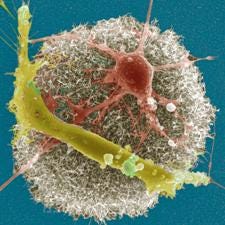Carbon Nanotubes Could Give Eyesight to the Blind
March 24, 2010

tel-aviv-university-bionic-eye
In this prototype, two rat neuron cells are bound to a rough carbon nanotube mat.
Researchers at Tel Aviv University (TAU) are growing living neurons from the brains of rats on nano-sized carbon tubes one-millionth of a millimeter in size, paving the way for the development of future retinal implants. By creating man-made neurons on a flexible nanomaterial suited for the small area in the eye in which new neuron connections are made, the scientists hope to improve vision--and perhaps even contribute to the development of a bionic eye.
"We're working to interface man-made technology with neurons," remarks Yael Hanein, a professor at TAU's School of Electrical Engineering. "It can be helpful in in vitro and in in vivo applications and provides an understanding of how neurons work so we can build better devices and drugs." The growth of living cells on a nanosubstrate is a very complicated process, she adds, but they adhere well to the structure, fusing with the synthetic electrical and physical interface.
One application of the scientists' research is to aid people with retinal degeneration diseases. Some researchers are investigating a prosthetic device for replacing the damaged cells in such retinal diseases as retinitis pigmentosa.
"Neurons like to form good links with our special nanotechnology, and we're now investigating applications for retinal implants," Hanein comments. "Our retinal implant attempts to replace activity in places of the damaged cells, and in the case of retinal diseases, the damaged photoreceptors."
More information on this research is available in the article "Seeing a Bionic Eye on Medicine's Horizon."
You May Also Like


